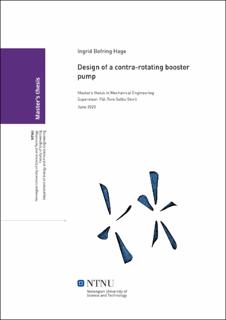| dc.contributor.advisor | Storli, Pål-Tore Selbo | |
| dc.contributor.advisor | Dagsvik, Helene Njølstad | |
| dc.contributor.author | Hage, Ingrid Befring | |
| dc.date.accessioned | 2023-05-15T17:26:44Z | |
| dc.date.available | 2023-05-15T17:26:44Z | |
| dc.date.issued | 2020 | |
| dc.identifier | no.ntnu:inspera:57317709:35324638 | |
| dc.identifier.uri | https://hdl.handle.net/11250/3068064 | |
| dc.description.abstract | Den aukande utbygginga av uregulerte energikjelder, som vind- og solkraft, gjer ei reguleringskjelde nødvendig. Dette kan oppnås ved bruk av pumpekraftverk til lagring av energien produsert av dei uregulerte kjeldene. I Noreg kan oppgradering av eksisterande vasskraftverk til pumpekraftverk vere mogleg. Ein reversibel pumpeturbin kan brukast i staden for ein konvensjonell turbin i pumpekraftverk, men denne maskina må òg fungere i pumpemodus. Ettersom ein turbin i eksisterande vasskraftverk ikkje vil vere nedsenka tilstrekkeleg for å unngå kavitasjon for den reversibel pumpeturbinen i pumpemodus, må løysningar som gir eit høgare trykk på denne lokasjonen undersøkast.
Dette problemet er blitt foreslått løyst ved bruk av ei boosterpumpe plassert framfor pumpeturbinen i pumpemodus. For å levere ein aksial strømming utan rotasjon ved utløpet på denne boosterpumpa, kan ei kontraroterande aksialpumpe nyttast. I tillegg bør boosterpumpa vere kompakt for å vere enkel å montere og gi ein måte å løfte den ut av strømmingen når pumpeturbinen er i turbinmodus. Dette kan la seg gjere ved å bruke same konseptet som rimdrevne thrusterene, som har motoren plassert i periferien av maskina.
I dette arbeidet er det utvikla eit design for ei kontraroterande boosterpumpe med motor plassert i periferien ved hjelp av blade element momentum metode. Dette designet blei deretter numerisk analysert ved hjelp av Ansys CFX i steady-state. For å undersøke dei hydrauliske eigenskapane til designet blei det brukt to forskjellige tilnærmingar for utrekning av løftehøgda. Begge desse tilnærmingane viser dårlege eigenskapar, med ein effektivitet på 15.39% og 13.37%. Ein mogleg årsaka til dette er det feilplasserte stagnasjonspunktet på pumpeblada. Dette antakast å vere eit resultat av eit design som ikkje yter under dei forhalda det er designa for. Dette fører til mistanke om at designmetoden som brukast ikkje er passande for en kontraroterende boosterpumpe. I tillegg oppstod det simuleringsproblem som gir grunnlag for usikkerheit i resultata frå den numeriske analysen. Dette betyr at det må gjerast ytterlegare undersøkingar av både designmetode og numerisk simulering av den kontraroterende boosterpumpen. | |
| dc.description.abstract | The increased use of unregulated energy sources, such as wind and solar power, makes a regulating source necessary. This could be provided using pumped hydroelectric storage as a way of storing the energy produced by the unregulated sources. In Norway, retrofitting existing hydropower plants for pumped hydroelectric storage could be possible. However, the problems concerning the retrofit must first be solved. A reversible pump turbine can be used in place of a conventional turbine in pumped hydroelectric storage, but this machine must operate in pump mode as well. As a turbine in an existing hydropower plant will not be submerged enough to avoid cavitation for the reversible pump turbine in pump mode, solutions providing a higher pressure at this location must be investigated.
This problem has been proposed solved by the use of a booster pump placed in front of the reversible pump turbine in pump mode. To provide an axial flow with no swirl at the outlet of this booster pump, a contra-rotating axial pump can be utilized. In addition, the booster pump should be compact to be easy to install and possibly provide a way of lifting it from the flow when the reversible pump turbine is in turbine mode. This can be provided using the same concept as rim-driven thrusters, which have the motor placed in the periphery of the machine.
In this work, a design for a contra-rotating booster pump of the rim-driven type has been developed using the blade element momentum method theory. This design was then numerically analyzed using Ansys CFX in steady-state. To evaluate the performance, two different approaches were used for the head calculations. Both of these show poor performance, with an efficiency of 15.39% and 13.37%. The possible cause for this was found to be a faulty placement of the stagnation point. This is believed to be a result of a design that does not fit the application it was meant for. This leads to suspicions if the design method used is not applicable to the contra-rotating booster pump. In addition, some simulation issues provide a basis for uncertainty in the results of the numerical analysis. Due to the lack of experimental data from a similar machine, the results of the numerical analysis have not been validated. This means that further investigations must be made into both the design method and numerical simulation of the contra-rotating booster pump. | |
| dc.language | eng | |
| dc.publisher | NTNU | |
| dc.title | Design of a contra-rotating booster pump | |
| dc.type | Master thesis | |
